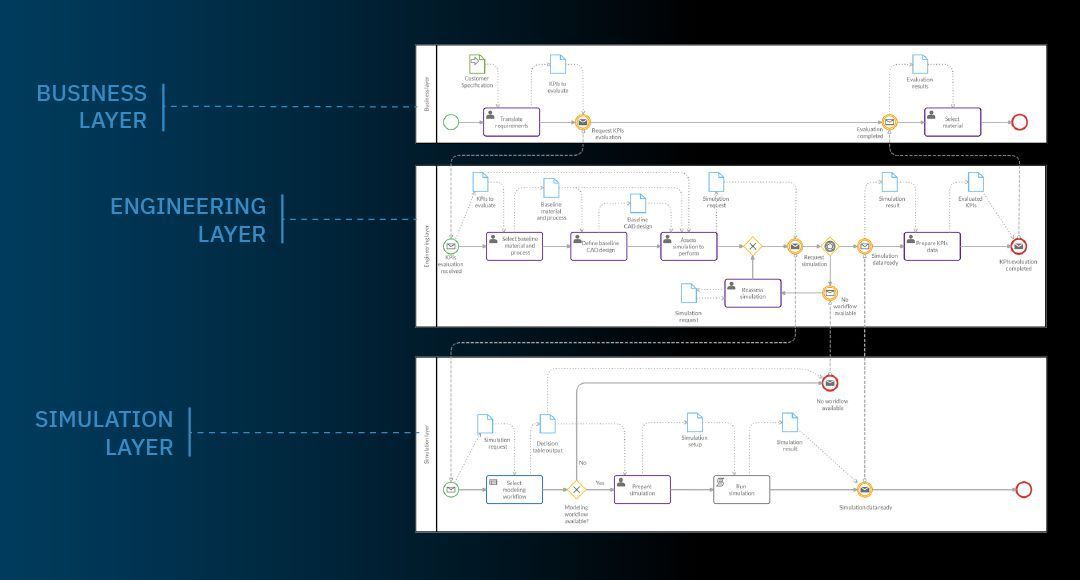Better informed decisions in the composite materials design through process and decision modeling
Written by Dario Campagna
15 April 2020 · 5 min read

As partners of the EU-funded COMPOSELECTOR project, we've contributed to the creation of a Business Decision Support System (BDSS) specifically tailored to enhance the informed decision making in the composite materials design and manufacturing. This innovative approach - based on real use cases from Airbus, Dow, and Goodyear - brought business management, engineering and simulation within a single framework. Read on to find out how our Business Process Management editor, Cardanit, played a key role in the project and fostered collaboration across departments and organizations.
Complex operational decisions are the norm when it comes to composite materials design and manufacturing. In fact, the decision-making in the composites design process happens at three levels: business, engineering, and simulation. To deliver competitive solutions in such a complex industry, these three levels need to interact and integrate smoothly and seamlessly from the earliest stages of the process.
Composites like carbon fiber and glass-reinforced plastic are nowadays used in many commercial products - from airplane wings and fuselages to vehicle tires and bicycle frames, to name a few. Replacing steel and other alloys with composites can lead to improvements in product performance and improved usability. But this comes at a cost.
Composite materials are in fact more expensive than traditional ones, increasing the need for cost-effective decisions early in the process.
The selection of new materials for a product needs to take into account different types of requirements and involves multiple decision-makers across departments.
The knowledge about the underlying process is often scattered inside the organization with no single source of truth nor a shared representation for such knowledge. This makes the management of the process difficult, if not impossible.
The knowledge about the underlying process is often scattered inside the organization with no single source of truth nor a shared representation for such knowledge.
Business decision-makers need access to tailored data from the engineering departments to make informed, timely decisions.
Meanwhile, engineering departments need timely input from the management to leverage numerical models and simulation software in the most effective way.
Different types of requirements need to be considered simultaneously starting from the early stages of design in order to deliver a competitive solution at the right moment.
Integrating business, engineering and simulation within a single framework
As mentioned above, the decision-making in the composite material design happens at three levels: business, engineering, and simulation.
This insight shaped the way materials modeling was coupled to business process and decision management in the EU-funded project COMPOSELECTOR. We’ve taken part in this project as a partner and capitalized on our 20-year expertise in process automation and standard-based solutions to develop our BPM (Business Process Management) online editor, Cardanit. Born originally as a research project under the name of BeePMN, Cardanit was used as the tool of reference for business and decision process modeling in COMPOSELECTOR.
With the help of Cardanit, we developed a Business Decision Support System (BDSS) that integrates material modeling with business process modeling within a single framework.
BDSSs are information systems that support and facilitate business decision-making processes. With a BDSS we can represent and store knowledge about existing decision processes. The BDSS can then use this knowledge to orchestrate processes and help people make informed decisions.
In the BDSS business processes are modeled using the Business Process Model and Notation 2.0 (BPMN 2.0) standard. Decisions are represented using the Decision Model and Notation (DMN) standard.
The availability of a single, interdisciplinary business process and decision workflow leads to better risk assessment, seamless knowledge sharing, cost reduction, and finally, increased design quality.
The availability of a single, interdisciplinary business process and decision workflow leads to better risk assessment, seamless knowledge sharing, cost reduction, and finally, increased design quality.
Collaboration is key: breaking silos with Cardanit collaboration features
In the preliminary development phase, we used Cardanit to model the business and decision processes underlying three application cases coming from the project’s industrial partners: Airbus, Dow and Goodyear.
Starting from textual descriptions of processes we created hierarchical top-down BPMN models. We adopted an iterative approach. Each iteration added details to the model and helped in building a shared understanding of the process.
The collaboration features of Cardanit fostered conversation on the business process.
It was key to the success of the application case analysis.
Business analysts and composite materials experts worked together throughout each of the iterations, sharing models and editing them in real-time.
BPMN models turned out to be both a knowledge representation tool and a tool for having conversations.
The BPMN models obtained with this iterative process collect all the knowledge about existing processes in a single cloud-based repository that can be updated in real-time and accessible by all the stakeholders anytime from any place.
In some cases, this knowledge was spread between different people in the industrial partner organization. Cardanit fostered conversations centered on BPMN models between those people too.
Real-life application cases at the heart of the BDSS
Three real-life application cases guided the development of COMPOSELECTOR - material and process selection of fuselage thermoplastic frame (Airbus), material and process selection of a leaf-spring (Dow), material and process selection of passenger tire platform with fixed carcass (Goodyear).
The three cases, coming from the three industrial partners of the COMPOSELECTOR project are different enough to make the proposed BDSS applicable for a wide range of decision processes in the field of composite material design.
This post was originally published on the Cardanit website.


